Financial Planning and Analysis: Management Accounting Report
VerifiedAdded on 2023/01/11
|8
|1990
|51
Report
AI Summary
This report provides a comprehensive analysis of management accounting principles applied to a clothing manufacturing company, Plus Samples. It begins with an introduction to management accounting, emphasizing its role in internal decision-making. The main body delves into various planning tools, including incremental, zero-based, and rolling budgets, as well as operating budgets, and their applications within the company. It identifies key financial issues faced by Plus Samples, such as lack of expense control and increasing inventory costs, and proposes solutions like variance analysis and the use of KPIs. The report also compares Plus Samples with Continental Clothing Limited, highlighting differences in accounting systems and techniques used to address financial challenges. The conclusion summarizes the importance of management accounting and the effectiveness of the discussed techniques. The report includes a list of references for further reading.
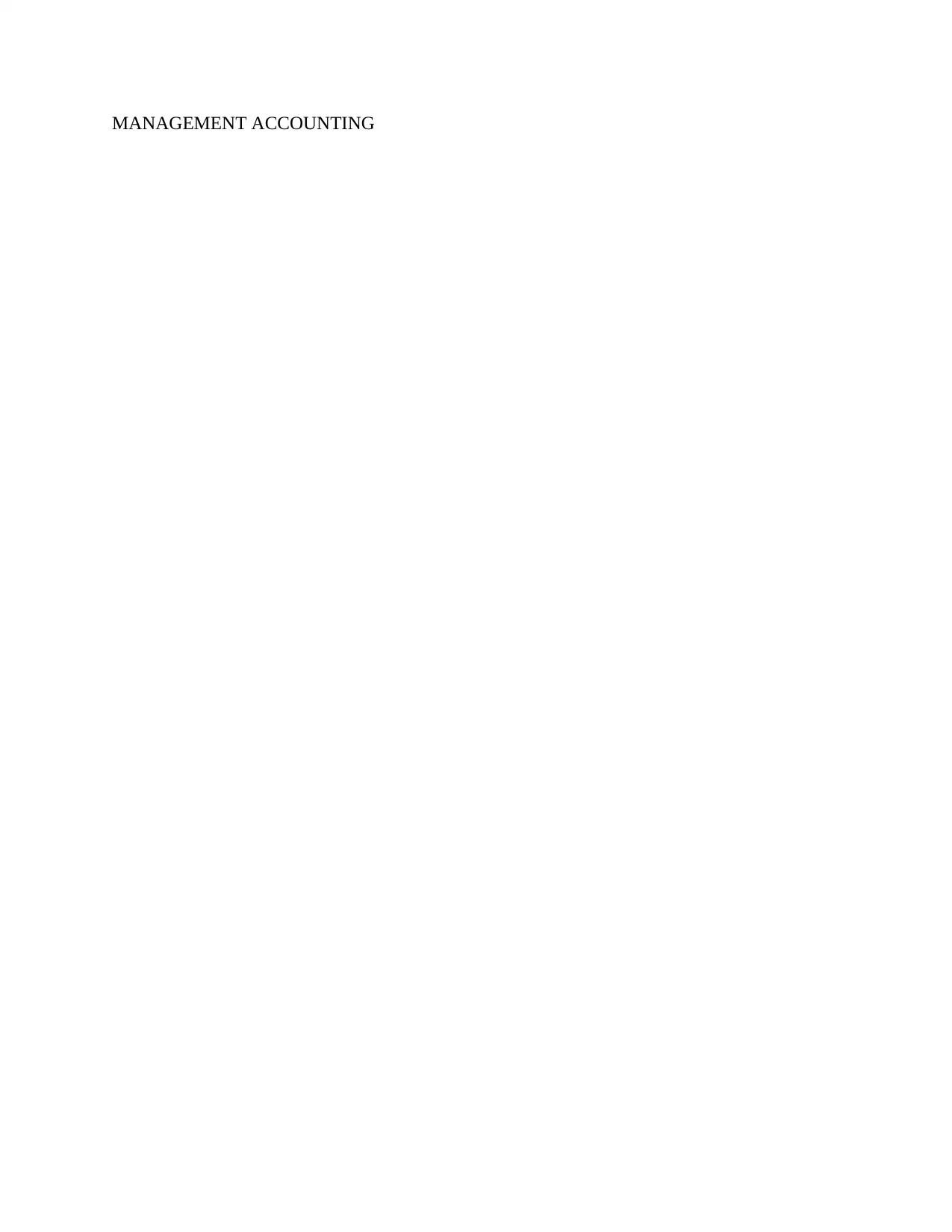
MANAGEMENT ACCOUNTING
Paraphrase This Document
Need a fresh take? Get an instant paraphrase of this document with our AI Paraphraser
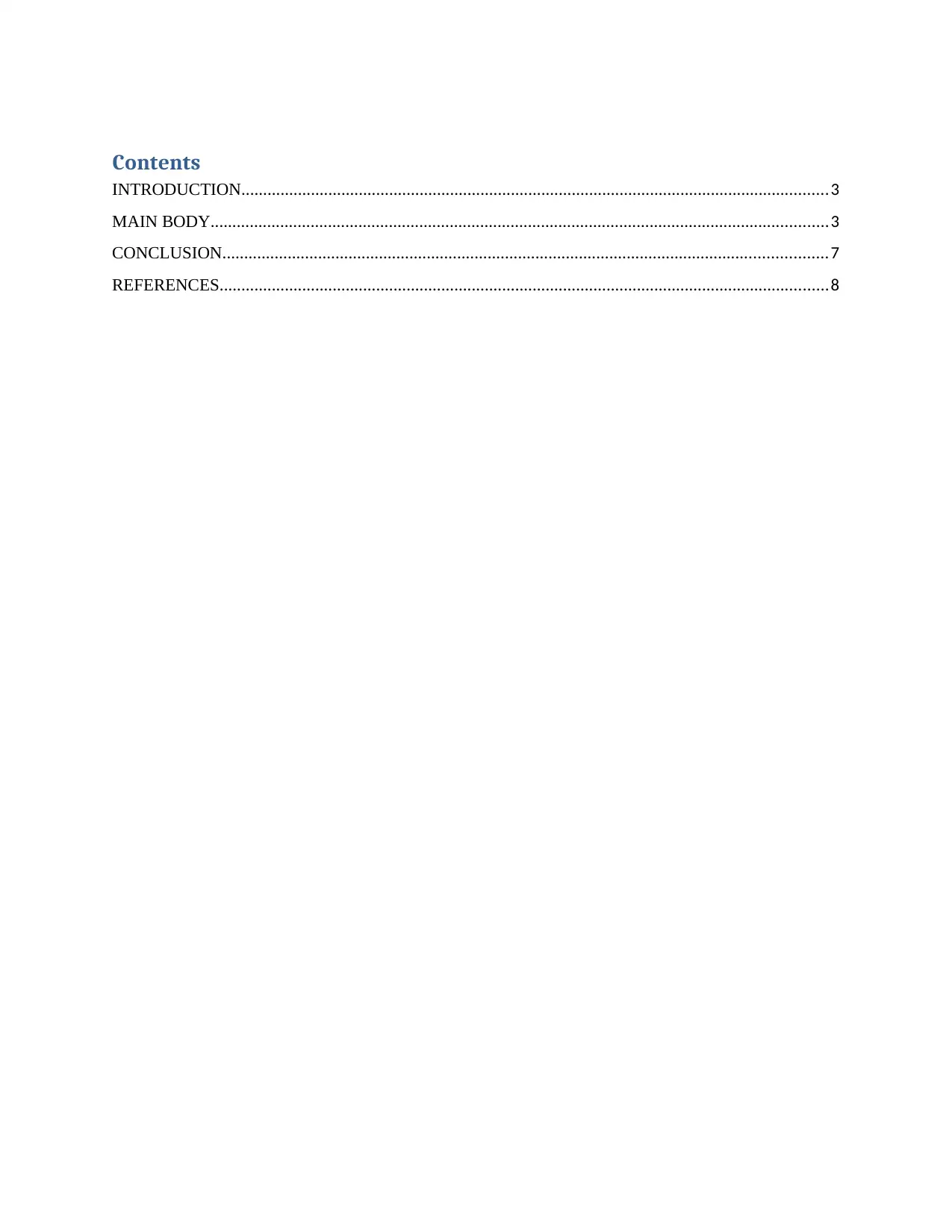
Contents
INTRODUCTION.......................................................................................................................................3
MAIN BODY..............................................................................................................................................3
CONCLUSION...........................................................................................................................................7
REFERENCES............................................................................................................................................8
INTRODUCTION.......................................................................................................................................3
MAIN BODY..............................................................................................................................................3
CONCLUSION...........................................................................................................................................7
REFERENCES............................................................................................................................................8
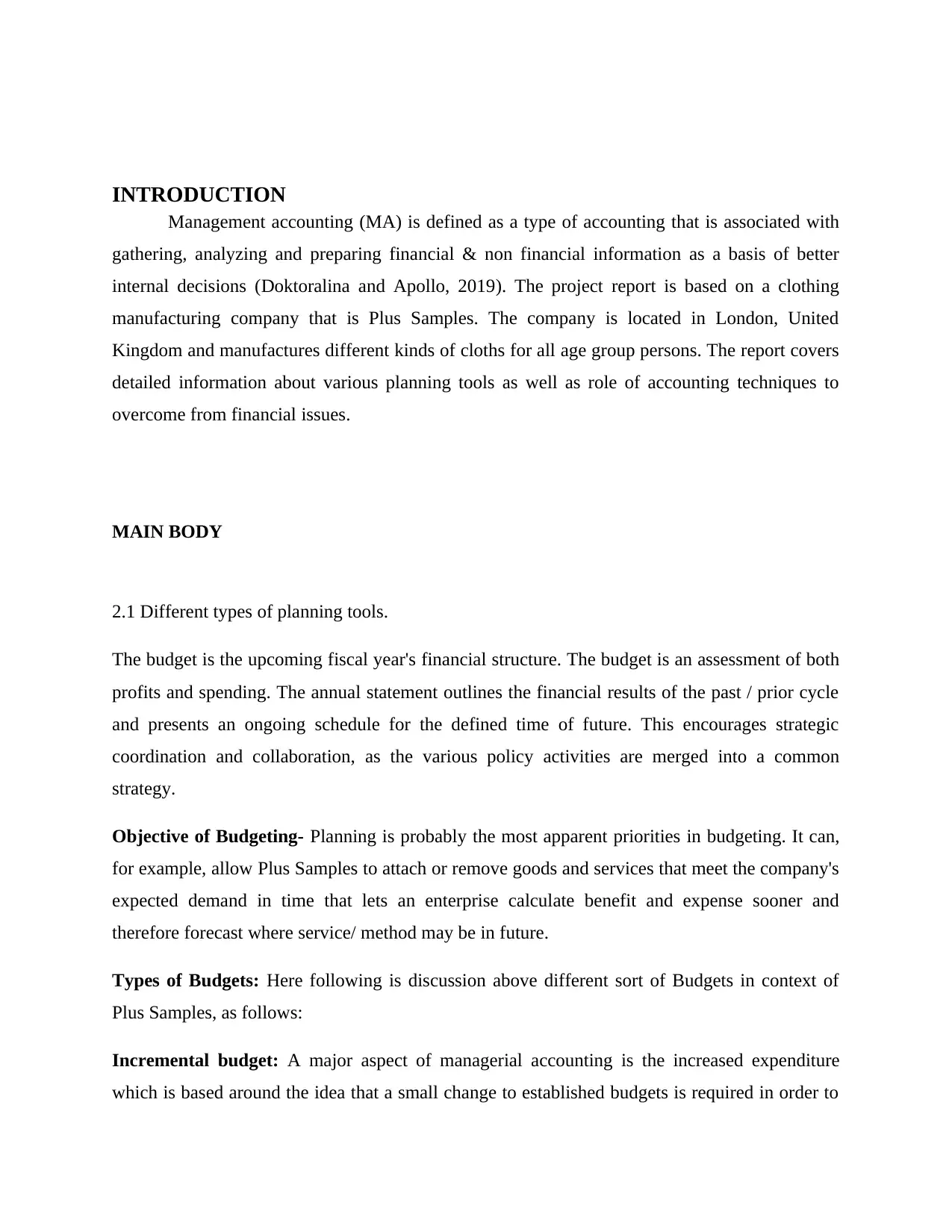
INTRODUCTION
Management accounting (MA) is defined as a type of accounting that is associated with
gathering, analyzing and preparing financial & non financial information as a basis of better
internal decisions (Doktoralina and Apollo, 2019). The project report is based on a clothing
manufacturing company that is Plus Samples. The company is located in London, United
Kingdom and manufactures different kinds of cloths for all age group persons. The report covers
detailed information about various planning tools as well as role of accounting techniques to
overcome from financial issues.
MAIN BODY
2.1 Different types of planning tools.
The budget is the upcoming fiscal year's financial structure. The budget is an assessment of both
profits and spending. The annual statement outlines the financial results of the past / prior cycle
and presents an ongoing schedule for the defined time of future. This encourages strategic
coordination and collaboration, as the various policy activities are merged into a common
strategy.
Objective of Budgeting- Planning is probably the most apparent priorities in budgeting. It can,
for example, allow Plus Samples to attach or remove goods and services that meet the company's
expected demand in time that lets an enterprise calculate benefit and expense sooner and
therefore forecast where service/ method may be in future.
Types of Budgets: Here following is discussion above different sort of Budgets in context of
Plus Samples, as follows:
Incremental budget: A major aspect of managerial accounting is the increased expenditure
which is based around the idea that a small change to established budgets is required in order to
Management accounting (MA) is defined as a type of accounting that is associated with
gathering, analyzing and preparing financial & non financial information as a basis of better
internal decisions (Doktoralina and Apollo, 2019). The project report is based on a clothing
manufacturing company that is Plus Samples. The company is located in London, United
Kingdom and manufactures different kinds of cloths for all age group persons. The report covers
detailed information about various planning tools as well as role of accounting techniques to
overcome from financial issues.
MAIN BODY
2.1 Different types of planning tools.
The budget is the upcoming fiscal year's financial structure. The budget is an assessment of both
profits and spending. The annual statement outlines the financial results of the past / prior cycle
and presents an ongoing schedule for the defined time of future. This encourages strategic
coordination and collaboration, as the various policy activities are merged into a common
strategy.
Objective of Budgeting- Planning is probably the most apparent priorities in budgeting. It can,
for example, allow Plus Samples to attach or remove goods and services that meet the company's
expected demand in time that lets an enterprise calculate benefit and expense sooner and
therefore forecast where service/ method may be in future.
Types of Budgets: Here following is discussion above different sort of Budgets in context of
Plus Samples, as follows:
Incremental budget: A major aspect of managerial accounting is the increased expenditure
which is based around the idea that a small change to established budgets is required in order to
⊘ This is a preview!⊘
Do you want full access?
Subscribe today to unlock all pages.

Trusted by 1+ million students worldwide
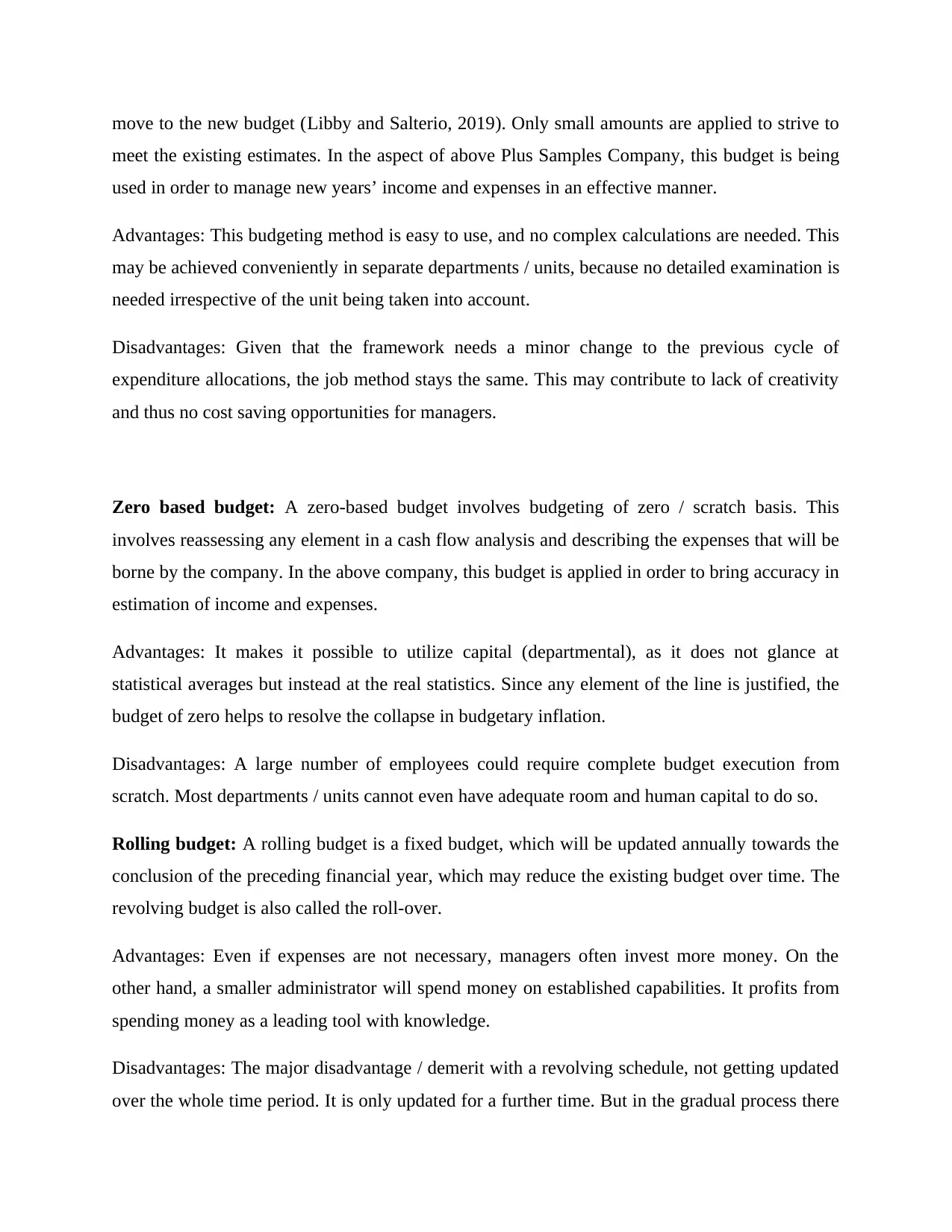
move to the new budget (Libby and Salterio, 2019). Only small amounts are applied to strive to
meet the existing estimates. In the aspect of above Plus Samples Company, this budget is being
used in order to manage new years’ income and expenses in an effective manner.
Advantages: This budgeting method is easy to use, and no complex calculations are needed. This
may be achieved conveniently in separate departments / units, because no detailed examination is
needed irrespective of the unit being taken into account.
Disadvantages: Given that the framework needs a minor change to the previous cycle of
expenditure allocations, the job method stays the same. This may contribute to lack of creativity
and thus no cost saving opportunities for managers.
Zero based budget: A zero-based budget involves budgeting of zero / scratch basis. This
involves reassessing any element in a cash flow analysis and describing the expenses that will be
borne by the company. In the above company, this budget is applied in order to bring accuracy in
estimation of income and expenses.
Advantages: It makes it possible to utilize capital (departmental), as it does not glance at
statistical averages but instead at the real statistics. Since any element of the line is justified, the
budget of zero helps to resolve the collapse in budgetary inflation.
Disadvantages: A large number of employees could require complete budget execution from
scratch. Most departments / units cannot even have adequate room and human capital to do so.
Rolling budget: A rolling budget is a fixed budget, which will be updated annually towards the
conclusion of the preceding financial year, which may reduce the existing budget over time. The
revolving budget is also called the roll-over.
Advantages: Even if expenses are not necessary, managers often invest more money. On the
other hand, a smaller administrator will spend money on established capabilities. It profits from
spending money as a leading tool with knowledge.
Disadvantages: The major disadvantage / demerit with a revolving schedule, not getting updated
over the whole time period. It is only updated for a further time. But in the gradual process there
meet the existing estimates. In the aspect of above Plus Samples Company, this budget is being
used in order to manage new years’ income and expenses in an effective manner.
Advantages: This budgeting method is easy to use, and no complex calculations are needed. This
may be achieved conveniently in separate departments / units, because no detailed examination is
needed irrespective of the unit being taken into account.
Disadvantages: Given that the framework needs a minor change to the previous cycle of
expenditure allocations, the job method stays the same. This may contribute to lack of creativity
and thus no cost saving opportunities for managers.
Zero based budget: A zero-based budget involves budgeting of zero / scratch basis. This
involves reassessing any element in a cash flow analysis and describing the expenses that will be
borne by the company. In the above company, this budget is applied in order to bring accuracy in
estimation of income and expenses.
Advantages: It makes it possible to utilize capital (departmental), as it does not glance at
statistical averages but instead at the real statistics. Since any element of the line is justified, the
budget of zero helps to resolve the collapse in budgetary inflation.
Disadvantages: A large number of employees could require complete budget execution from
scratch. Most departments / units cannot even have adequate room and human capital to do so.
Rolling budget: A rolling budget is a fixed budget, which will be updated annually towards the
conclusion of the preceding financial year, which may reduce the existing budget over time. The
revolving budget is also called the roll-over.
Advantages: Even if expenses are not necessary, managers often invest more money. On the
other hand, a smaller administrator will spend money on established capabilities. It profits from
spending money as a leading tool with knowledge.
Disadvantages: The major disadvantage / demerit with a revolving schedule, not getting updated
over the whole time period. It is only updated for a further time. But in the gradual process there
Paraphrase This Document
Need a fresh take? Get an instant paraphrase of this document with our AI Paraphraser
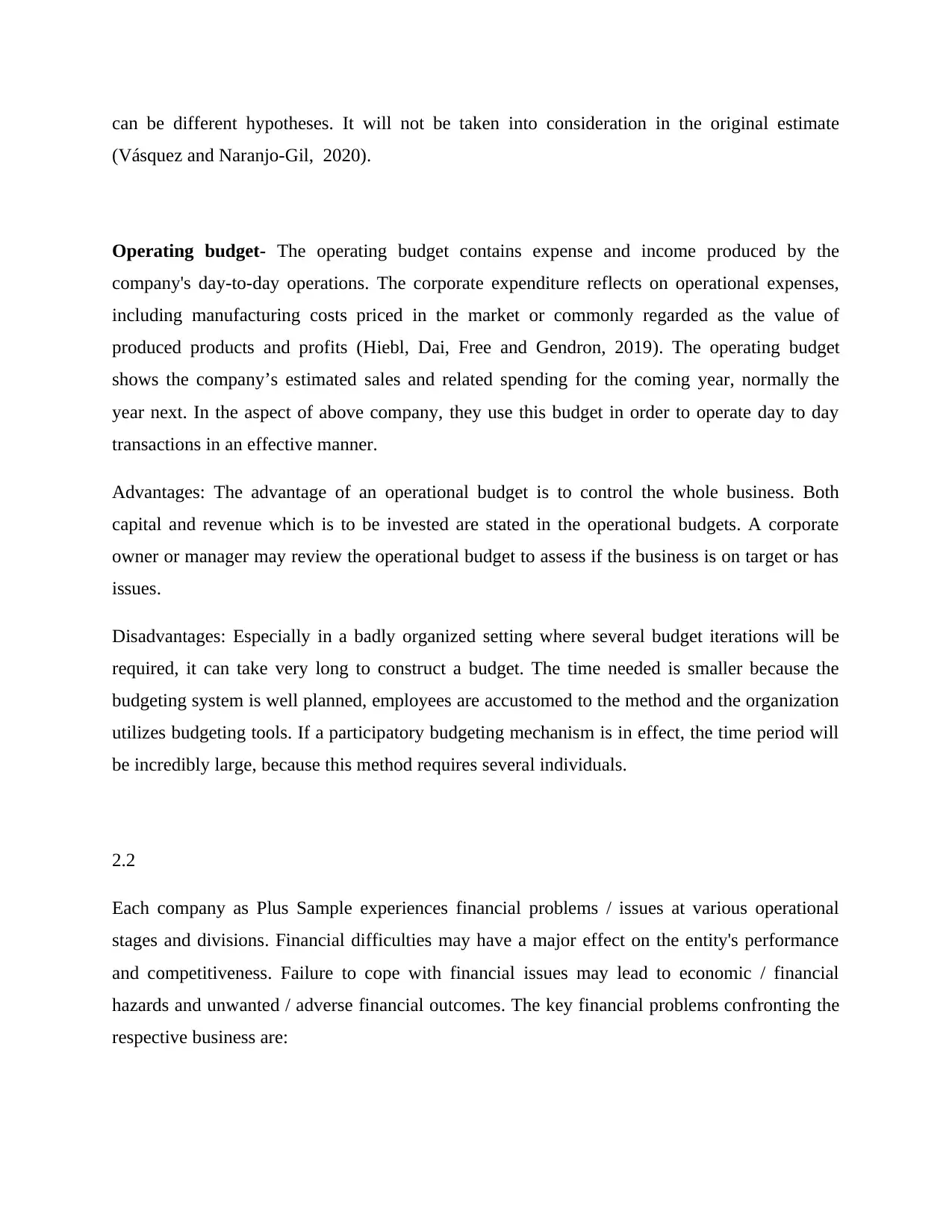
can be different hypotheses. It will not be taken into consideration in the original estimate
(Vásquez and Naranjo-Gil, 2020).
Operating budget- The operating budget contains expense and income produced by the
company's day-to-day operations. The corporate expenditure reflects on operational expenses,
including manufacturing costs priced in the market or commonly regarded as the value of
produced products and profits (Hiebl, Dai, Free and Gendron, 2019). The operating budget
shows the company’s estimated sales and related spending for the coming year, normally the
year next. In the aspect of above company, they use this budget in order to operate day to day
transactions in an effective manner.
Advantages: The advantage of an operational budget is to control the whole business. Both
capital and revenue which is to be invested are stated in the operational budgets. A corporate
owner or manager may review the operational budget to assess if the business is on target or has
issues.
Disadvantages: Especially in a badly organized setting where several budget iterations will be
required, it can take very long to construct a budget. The time needed is smaller because the
budgeting system is well planned, employees are accustomed to the method and the organization
utilizes budgeting tools. If a participatory budgeting mechanism is in effect, the time period will
be incredibly large, because this method requires several individuals.
2.2
Each company as Plus Sample experiences financial problems / issues at various operational
stages and divisions. Financial difficulties may have a major effect on the entity's performance
and competitiveness. Failure to cope with financial issues may lead to economic / financial
hazards and unwanted / adverse financial outcomes. The key financial problems confronting the
respective business are:
(Vásquez and Naranjo-Gil, 2020).
Operating budget- The operating budget contains expense and income produced by the
company's day-to-day operations. The corporate expenditure reflects on operational expenses,
including manufacturing costs priced in the market or commonly regarded as the value of
produced products and profits (Hiebl, Dai, Free and Gendron, 2019). The operating budget
shows the company’s estimated sales and related spending for the coming year, normally the
year next. In the aspect of above company, they use this budget in order to operate day to day
transactions in an effective manner.
Advantages: The advantage of an operational budget is to control the whole business. Both
capital and revenue which is to be invested are stated in the operational budgets. A corporate
owner or manager may review the operational budget to assess if the business is on target or has
issues.
Disadvantages: Especially in a badly organized setting where several budget iterations will be
required, it can take very long to construct a budget. The time needed is smaller because the
budgeting system is well planned, employees are accustomed to the method and the organization
utilizes budgeting tools. If a participatory budgeting mechanism is in effect, the time period will
be incredibly large, because this method requires several individuals.
2.2
Each company as Plus Sample experiences financial problems / issues at various operational
stages and divisions. Financial difficulties may have a major effect on the entity's performance
and competitiveness. Failure to cope with financial issues may lead to economic / financial
hazards and unwanted / adverse financial outcomes. The key financial problems confronting the
respective business are:
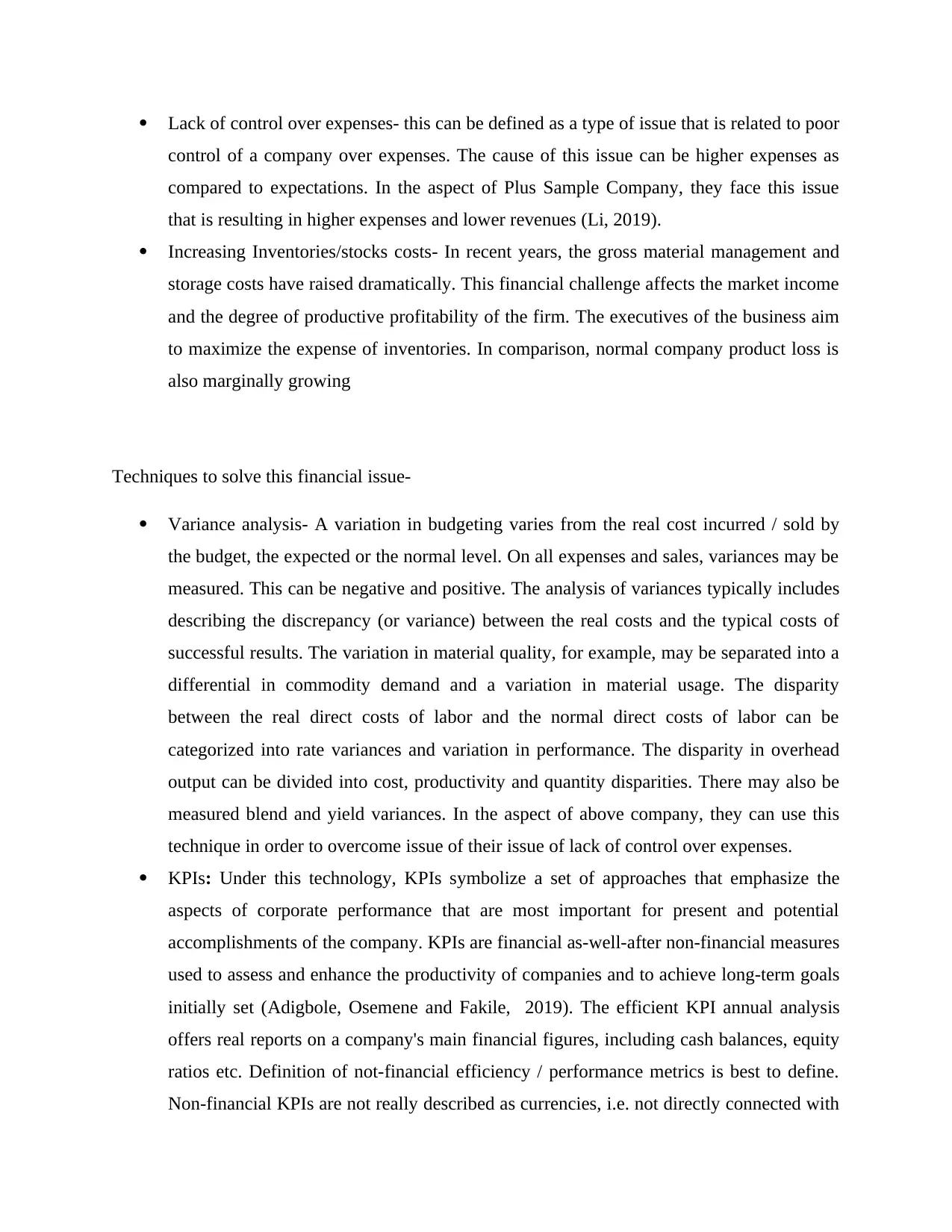
Lack of control over expenses- this can be defined as a type of issue that is related to poor
control of a company over expenses. The cause of this issue can be higher expenses as
compared to expectations. In the aspect of Plus Sample Company, they face this issue
that is resulting in higher expenses and lower revenues (Li, 2019).
Increasing Inventories/stocks costs- In recent years, the gross material management and
storage costs have raised dramatically. This financial challenge affects the market income
and the degree of productive profitability of the firm. The executives of the business aim
to maximize the expense of inventories. In comparison, normal company product loss is
also marginally growing
Techniques to solve this financial issue-
Variance analysis- A variation in budgeting varies from the real cost incurred / sold by
the budget, the expected or the normal level. On all expenses and sales, variances may be
measured. This can be negative and positive. The analysis of variances typically includes
describing the discrepancy (or variance) between the real costs and the typical costs of
successful results. The variation in material quality, for example, may be separated into a
differential in commodity demand and a variation in material usage. The disparity
between the real direct costs of labor and the normal direct costs of labor can be
categorized into rate variances and variation in performance. The disparity in overhead
output can be divided into cost, productivity and quantity disparities. There may also be
measured blend and yield variances. In the aspect of above company, they can use this
technique in order to overcome issue of their issue of lack of control over expenses.
KPIs: Under this technology, KPIs symbolize a set of approaches that emphasize the
aspects of corporate performance that are most important for present and potential
accomplishments of the company. KPIs are financial as-well-after non-financial measures
used to assess and enhance the productivity of companies and to achieve long-term goals
initially set (Adigbole, Osemene and Fakile, 2019). The efficient KPI annual analysis
offers real reports on a company's main financial figures, including cash balances, equity
ratios etc. Definition of not-financial efficiency / performance metrics is best to define.
Non-financial KPIs are not really described as currencies, i.e. not directly connected with
control of a company over expenses. The cause of this issue can be higher expenses as
compared to expectations. In the aspect of Plus Sample Company, they face this issue
that is resulting in higher expenses and lower revenues (Li, 2019).
Increasing Inventories/stocks costs- In recent years, the gross material management and
storage costs have raised dramatically. This financial challenge affects the market income
and the degree of productive profitability of the firm. The executives of the business aim
to maximize the expense of inventories. In comparison, normal company product loss is
also marginally growing
Techniques to solve this financial issue-
Variance analysis- A variation in budgeting varies from the real cost incurred / sold by
the budget, the expected or the normal level. On all expenses and sales, variances may be
measured. This can be negative and positive. The analysis of variances typically includes
describing the discrepancy (or variance) between the real costs and the typical costs of
successful results. The variation in material quality, for example, may be separated into a
differential in commodity demand and a variation in material usage. The disparity
between the real direct costs of labor and the normal direct costs of labor can be
categorized into rate variances and variation in performance. The disparity in overhead
output can be divided into cost, productivity and quantity disparities. There may also be
measured blend and yield variances. In the aspect of above company, they can use this
technique in order to overcome issue of their issue of lack of control over expenses.
KPIs: Under this technology, KPIs symbolize a set of approaches that emphasize the
aspects of corporate performance that are most important for present and potential
accomplishments of the company. KPIs are financial as-well-after non-financial measures
used to assess and enhance the productivity of companies and to achieve long-term goals
initially set (Adigbole, Osemene and Fakile, 2019). The efficient KPI annual analysis
offers real reports on a company's main financial figures, including cash balances, equity
ratios etc. Definition of not-financial efficiency / performance metrics is best to define.
Non-financial KPIs are not really described as currencies, i.e. not directly connected with
⊘ This is a preview!⊘
Do you want full access?
Subscribe today to unlock all pages.

Trusted by 1+ million students worldwide
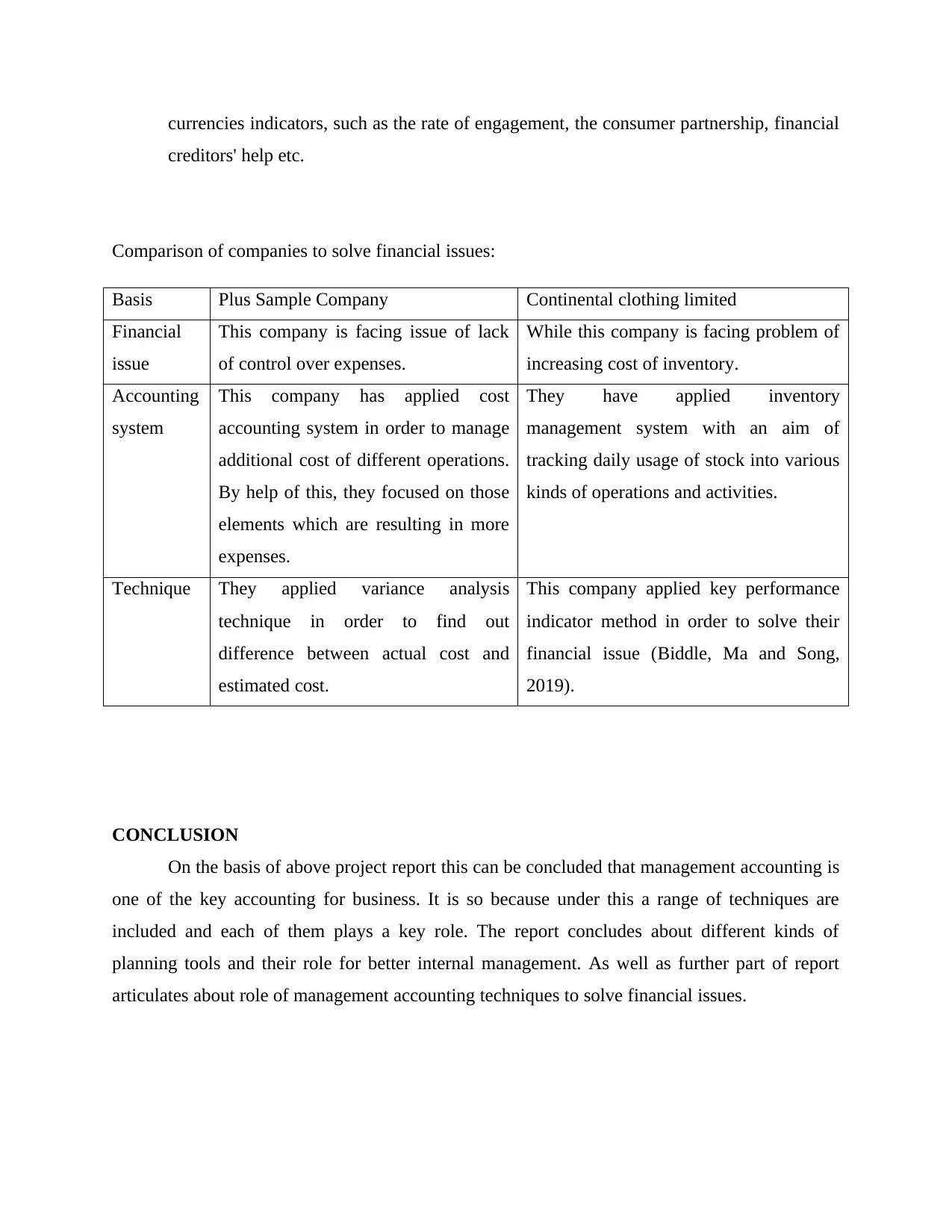
currencies indicators, such as the rate of engagement, the consumer partnership, financial
creditors' help etc.
Comparison of companies to solve financial issues:
Basis Plus Sample Company Continental clothing limited
Financial
issue
This company is facing issue of lack
of control over expenses.
While this company is facing problem of
increasing cost of inventory.
Accounting
system
This company has applied cost
accounting system in order to manage
additional cost of different operations.
By help of this, they focused on those
elements which are resulting in more
expenses.
They have applied inventory
management system with an aim of
tracking daily usage of stock into various
kinds of operations and activities.
Technique They applied variance analysis
technique in order to find out
difference between actual cost and
estimated cost.
This company applied key performance
indicator method in order to solve their
financial issue (Biddle, Ma and Song,
2019).
CONCLUSION
On the basis of above project report this can be concluded that management accounting is
one of the key accounting for business. It is so because under this a range of techniques are
included and each of them plays a key role. The report concludes about different kinds of
planning tools and their role for better internal management. As well as further part of report
articulates about role of management accounting techniques to solve financial issues.
creditors' help etc.
Comparison of companies to solve financial issues:
Basis Plus Sample Company Continental clothing limited
Financial
issue
This company is facing issue of lack
of control over expenses.
While this company is facing problem of
increasing cost of inventory.
Accounting
system
This company has applied cost
accounting system in order to manage
additional cost of different operations.
By help of this, they focused on those
elements which are resulting in more
expenses.
They have applied inventory
management system with an aim of
tracking daily usage of stock into various
kinds of operations and activities.
Technique They applied variance analysis
technique in order to find out
difference between actual cost and
estimated cost.
This company applied key performance
indicator method in order to solve their
financial issue (Biddle, Ma and Song,
2019).
CONCLUSION
On the basis of above project report this can be concluded that management accounting is
one of the key accounting for business. It is so because under this a range of techniques are
included and each of them plays a key role. The report concludes about different kinds of
planning tools and their role for better internal management. As well as further part of report
articulates about role of management accounting techniques to solve financial issues.
Paraphrase This Document
Need a fresh take? Get an instant paraphrase of this document with our AI Paraphraser
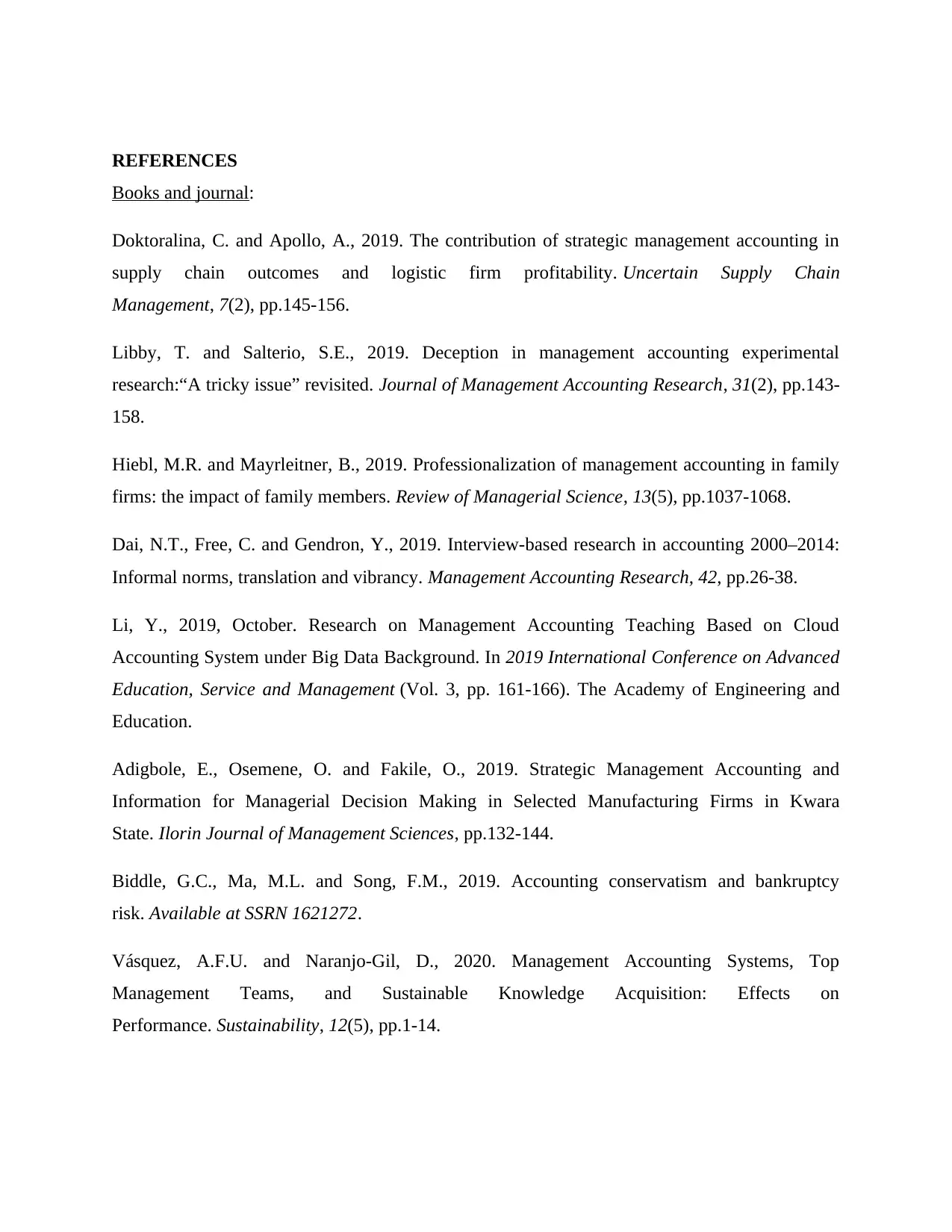
REFERENCES
Books and journal:
Doktoralina, C. and Apollo, A., 2019. The contribution of strategic management accounting in
supply chain outcomes and logistic firm profitability. Uncertain Supply Chain
Management, 7(2), pp.145-156.
Libby, T. and Salterio, S.E., 2019. Deception in management accounting experimental
research:“A tricky issue” revisited. Journal of Management Accounting Research, 31(2), pp.143-
158.
Hiebl, M.R. and Mayrleitner, B., 2019. Professionalization of management accounting in family
firms: the impact of family members. Review of Managerial Science, 13(5), pp.1037-1068.
Dai, N.T., Free, C. and Gendron, Y., 2019. Interview-based research in accounting 2000–2014:
Informal norms, translation and vibrancy. Management Accounting Research, 42, pp.26-38.
Li, Y., 2019, October. Research on Management Accounting Teaching Based on Cloud
Accounting System under Big Data Background. In 2019 International Conference on Advanced
Education, Service and Management (Vol. 3, pp. 161-166). The Academy of Engineering and
Education.
Adigbole, E., Osemene, O. and Fakile, O., 2019. Strategic Management Accounting and
Information for Managerial Decision Making in Selected Manufacturing Firms in Kwara
State. Ilorin Journal of Management Sciences, pp.132-144.
Biddle, G.C., Ma, M.L. and Song, F.M., 2019. Accounting conservatism and bankruptcy
risk. Available at SSRN 1621272.
Vásquez, A.F.U. and Naranjo-Gil, D., 2020. Management Accounting Systems, Top
Management Teams, and Sustainable Knowledge Acquisition: Effects on
Performance. Sustainability, 12(5), pp.1-14.
Books and journal:
Doktoralina, C. and Apollo, A., 2019. The contribution of strategic management accounting in
supply chain outcomes and logistic firm profitability. Uncertain Supply Chain
Management, 7(2), pp.145-156.
Libby, T. and Salterio, S.E., 2019. Deception in management accounting experimental
research:“A tricky issue” revisited. Journal of Management Accounting Research, 31(2), pp.143-
158.
Hiebl, M.R. and Mayrleitner, B., 2019. Professionalization of management accounting in family
firms: the impact of family members. Review of Managerial Science, 13(5), pp.1037-1068.
Dai, N.T., Free, C. and Gendron, Y., 2019. Interview-based research in accounting 2000–2014:
Informal norms, translation and vibrancy. Management Accounting Research, 42, pp.26-38.
Li, Y., 2019, October. Research on Management Accounting Teaching Based on Cloud
Accounting System under Big Data Background. In 2019 International Conference on Advanced
Education, Service and Management (Vol. 3, pp. 161-166). The Academy of Engineering and
Education.
Adigbole, E., Osemene, O. and Fakile, O., 2019. Strategic Management Accounting and
Information for Managerial Decision Making in Selected Manufacturing Firms in Kwara
State. Ilorin Journal of Management Sciences, pp.132-144.
Biddle, G.C., Ma, M.L. and Song, F.M., 2019. Accounting conservatism and bankruptcy
risk. Available at SSRN 1621272.
Vásquez, A.F.U. and Naranjo-Gil, D., 2020. Management Accounting Systems, Top
Management Teams, and Sustainable Knowledge Acquisition: Effects on
Performance. Sustainability, 12(5), pp.1-14.
1 out of 8
Related Documents
Your All-in-One AI-Powered Toolkit for Academic Success.
+13062052269
info@desklib.com
Available 24*7 on WhatsApp / Email
![[object Object]](/_next/static/media/star-bottom.7253800d.svg)
Unlock your academic potential
Copyright © 2020–2025 A2Z Services. All Rights Reserved. Developed and managed by ZUCOL.





